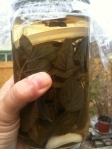I love vinegars. Yes, plural… I am up to eighteen different kinds at the moment. Listen, they each have a distinctive flavor and characteristics, and I use them all. I see them as an addition to my spice and herb arsenal, just a different way of flavor-layering. And, even though I could use plenty of salt in cooking, I find that I often prefer vinegars; they work well as a natural salt substitute in many cases.
I have almost-sweet vinegars with light fruity flavors, like raspberry white wine vinegar. I love it in a fruit salad; just a little vinegar and honey is a great “dressing”. The medium flavors, the herb and (oh my!) truffle infused whites have their place in vinaigrettes for salads like Belgian Endive Salad, and in dishes like French lentils. I’m making myself hungry!
Balsamic, (real balsamic, none of that caramel colored puny stuff, oh I’m such a snob) can be amazing cooked with white beans, or added as a “finish”. I even have an orange-infused balsamic that I use in my Gluten- and Egg-free Chocolate Cake occasionally as a change from cider vinegar.
Which segues me nicely to cider vinegar, rice vinegar, date vinegar, fig vinegar, and (a recent discovery) coconut vinegar. These heady and fascinating liquids meet the dictionary definition of vinegar (a sour-tasting liquid containing acetic acid, obtained by fermenting dilute alcoholic liquids, typically wine, cider, or beer, and used as a condiment or for pickling) even though they may have nothing to do with wine per se (my dicco says “ORIGIN Middle English : from Old French vyn egre, based on Latin vinum ‘wine’ + acer ‘sour.’).
Lucky for me, our local extension service offered a class on culinary herbs a few months ago, and the presenter, a chef and Master Gardener was a great source of information on both growing herbs and herb vinegars.
I had tried making my own herb vinegars in the past, using white wine vinegar (not white vinegar, which I relegate to cleaning purposes – oh I am a snob) but I was never satisfied. The vinegars seemed too harsh and sort of raw tasting. Our speaker’s trick is to use rice vinegar. She’s right, it works a treat. Rice vinegar is a delicate vinegar, willing to be influenced by additional flavors and happy to meld rather than fight with them. And it is inexpensive and fairly easy to find.
So, as you plan your summer herb gardens, or if you find yourself with more fresh herbs than you can use before they get nasty, think herb vinegar. It couldn’t be simpler, really. All you need is:
“Homemade” Herb Vinegar
rice vinegar
several bunches of fresh herbs of your choice
1 clean wide mouth glass jar with a good lid
1 plastic cup cover**
plastic wrap
coffee filters and a funnel
Tuck the clean dry herbs in the glass jar. Cover with rice vinegar. Cut a slit in the cup cover so you can slide it into the jar and it will pop open to keep the herbs submerged. Place a layer of plastic wrap between the jar and the lid so the vinegar won’t rust or otherwise bother the top.
Cover tightly and keep in a cool dark corner of you kitchen. Add herbs as often as you like, and if the liquid becomes cloudy just strain it through a coffee filter.
***
It is ready for use almost immediately; when asked how long we needed to wait our presenter said overnight! You can certainly have several jars going at once with different herb blends.
I am trying a vinegar with my calamondins. I’ll let you know how it turns out. It sure smells goooooood!
Disclaimer: We were told in class that there was no need to refrigerate these home-made vinegars; the acid was enough to keep it safe. I can only tell you that I have had no trouble with any that I’ve tried. Use your own judgment, of course, and keep everything clean.
Have fun. Let us know what flavor combinations you come up with and how you use them. Enjoy!


This sounds like fun. I’m going to look for rice vinegar. Have you tried adding onions and garlic? How did that work?
By: first50 on February 21, 2011
at 2:46 pm
I haven’t tried onions, but there are actually 2 garlic cloves in my bottle of herb vinegar. I just peeled the clove and dropped it in, didn’t mash it or cut it up or anything. Its subtle, but I wasn’t looking to make garlic vinegar, you know what I mean? You should be able to find rice vinegar at any big supermarket in the “International Foods” aisle, or even at Trader Joe’s. Have fun and let us know what you add and how it tastes, please!! Mmmmmmmm….!
By: Rachel on February 21, 2011
at 3:26 pm